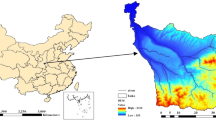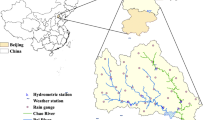Abstract
The impact and optimal control of non-point source (NPS) pollution on water environment have become the hot issues of current research. This paper simulates the characteristics of NPS pollution of Danjiang River Basin in 2013, 2014, 2016, and 2018 based on SWAT (Soil and Water Assessment Tool) model. The spatial and temporal distribution is analyzed, and the critical source areas (CSA) according to the intensity of pollution loss are identified. Then, we set up nine single best management practices (BMPs) and three combined BMPs in the CSA, and the reduction effects of NPS pollution load of BMPs at the HRU scale and sub-basin scale are evaluated. The main research conclusions are as follows: (1) Based on the measured water quality and quantity data of Danfeng section from 2011 to 2019, the mean concentration method and the runoff division method are used to estimate the NPS pollution load at the Danfeng section, the NPS pollution loads of the total phosphorus (TP), ammonia nitrogen (NH3-N) and COD account for a large proportion in the total loads, which are 60.95–75.91%, 39.43–56.40%, and 59.37–74.37%, respectively. (2) In terms of temporal distribution, the impact to NPS pollution load is ranked as runoff > sediment > rainfall. In terms of spatial distribution, sediment has a great impact on nitrogen and phosphorus NPS pollution load. (3) The unit area load index method and the natural crack point classification method are used to identify the CSA in the basin. The information-entropy-basedmulti-attribute decision-making method to evaluate the cost-benefit value of management measures shows that control measures preferentially use combined BMPs, and the comprehensive cost-benefit attribute value reaches above 0.8. When using a single BMP, the comprehensive attribute value of returning the grain plots to forestry is high, reaching 0.62, which is suitable for NPS pollution control in a small area; for large-scale NPS pollution control, terrace project, supplemented by residue cover and grassed waterways is the more effective way in the river basin.













Similar content being viewed by others
Data availability
The datasets generated and analyzed during the current study are not publicly available due [REASON WHY DATA ARE NOT PUBLIC] but are available from the corresponding author on reasonable request.
References
Abunada Z, Kishawi Y, Alslaibi TM, Kaheil N, Mittelstet A (2020) The application of SWAT-GIS tool to improve the recharge factor in the drastic framework: case study. J Hydrol 592:125613
Arabi M, Govindaraju RS, Hantush MM (2006)Cost-effective allocation of watershed management practices using a genetic algorithm. Water Resour Res 42(10):2405–2411
Arnold JG, Kiniry JR, Srinivasan R, Williams JR, Haney EB (2011) Soil and Water Assessment Tool Input/Output File Documentation. Version 2012.
Bauwe A, Tiedemann S, Kahle P, Lennartz B (2017) Does the temporal resolution of precipitation input influence the simulated hydrological components employing the SWAT Model? JAWRA J Am Water Resour Assoc 53(1):997–1007
Chawanda CJ, George C, Thiery W, Griensven AV, Srinivasan R (2020)User-friendly workflows for catchment modelling: towards reproducible SWAT+ model studies. Environ Model Softw 104812
Fei X, Dong G, Wang Q, Liu L, Liu R (2016) Impacts of DEM uncertainties on CSA identification for NPS pollution control based on SWAT model. J Hydrol 540:355–367
Geng R, Liang X, Yin P, Wang M, Zhou L (2019) Research progress on multi-objective collaborative optimal allocation of optimal management measures for NPS pollution. Acta Ecol Sin 39(08):27–35 (in Chinese)
Han K, Kleinman PJA, Saporito LS et al (2015) Phosphorus and Nitrogen Leaching Before and After Tillage and Urea Application. J Environ Qual 44(2):560–571
Lam QD, Schmalz B, Fohrer N (2010) Modelling point and diffuse source pollution of nitrate in a rural lowland catchment using the SWAT model. Agric Water Manag 97(2):317–325
Li HE (2000) Average concentration method for estimating NPS pollution load and its application. Acta Sci Circumst 04:397–400 (in Chinese)
Ling W, Fan Y, Sun C, Liu G (2019) A review of the research hotspots on the best management measures of NPS pollution. Environ Pollut Prevent 41(03):109–113 (in Chinese)
Liu R, Xu F, Zhang P, Yu W, Men C (2016) Identifying NPS CSA based on multi-factors at a basin scale with SWAT. J Hydrol 533:379–388
Luo Y, Zhang M (2009)Management-oriented sensitivity analysis for pesticide transport in watershed-scale water quality modeling using SWAT. Environ Pollut 157(12):3370–3378
Maringanti CT, Chaubey I, Arabi M, Engel B (2011) Application of a multi-objective optimization method to provide least cost alternatives for nps pollution control. Environ Manag 48(3):448–461
Panagopoulos Y, Makropoulos C, Baltas E, Mimikou M (2011a) SWAT parameterization for the identification of critical diffuse pollution source areas under data limitations. Ecol Model 222(19):3500–3512
Panagopoulos Y, Makropoulos C, Mimikou M (2011b) Reducing surface water pollution through the assessment of the cost-effectiveness of BMPs at different spatial scales. J Environ Manag 92(10):2823–2835
Pastor AV, Ludwig F, Biemans H, Hoff H, Kabat P (2014) Accounting for environmental flow requirements in global water assessments. Hydrol Earth Syst Sci Discuss 10(12):14987–15032
Pavinato PS, Merlin A, Rosolem CA (2009) Phosphorus fractions in Brazilian Cerrado soils as affected by tillage. Soil Tillage Res 105(1):149–155
Phiri WK, Vanzo D, Banda K, Nyirenda E, Nyambe IA (2020) A pseudo-reservoir concept in SWAT model for the simulation of an alluvial floodplain in a complex tropical river system. Regional Studies, Journal of Hydrology, p 33
Rodriguez HG, Popp J, Maringanti C, Chaubey I (2011) Selection and placement of best management practices used to reduce water quality degradation in lincoln lake watershed. Water Resour Res 47(1):99–112
Romagnoli M, Portapila M, Rigalli A, Maydana G, Burgues M, Garcia CM (2017) Assessment of the SWAT model to simulate a watershed with limited available data in the Pampas region, Argentina. Sci Total Environ s 596–597(OCT.15):437–450
Samimi M, Mirchi A, Moriasi D, Ahn S, Sheng Z (2020) Modeling arid/semi-arid irrigated agricultural watersheds with SWAT: applications, challenges, and solution strategies. Journal of Hydrology, 590.
Shrestha NK, Akhtar T, Ghimire U, Rudra RP, Daggupati P (2020) Can-GLWS: Canadian great lakes weather service for the soil and water assessment tool (SWAT) modelling. J Great Lakes Res
Stoddard JL, Sickle JV, Herlihy AT, Brahney J, Paulsen S, Peck DV et al (2016)Continental-scale increase in lake and stream phosphorus: are oligotrophic systems disappearing in the U.S. Environ Sci Technol 50(7):3409
Sun T, Zhang H, Wang Y (2013) The application of information entropy in basin level water waste permits allocation in china. Resour Conserv Recycl 70(70):50–54
Wang X, Hao FH, Zhang X (2013) Optimum management of NPS pollution in Danjiangkou Reservoir watershed. China Environ Sci 33(07):1335–1343 (in Chinese)
Xi L (2012) Preliminary estimation of total pollutant load in the mainstream of Danjiang River. Shaanxi Water Conservancy 05:97–99
Xu F, Dong GX, Wang QR, Liu LM, Yu WW, Men C, Liu RM (2016) Impacts of dem uncertainties on critical source areas identification for non-point source pollution control based on swat model. Journal of Hydrology 540:355–367
Yang S, Dong G, Zheng D, Xiao H, Gao Y, Lang Y (2011) Coupling Xinanjiang model and SWAT to simulate agricultural NPS pollution in Songtao watershed of Hainan, china. Ecol Model 222(20–22):3701–3717
Yasin HQ, Clemente RS (2014) Application of SWAT model for hydrologic and Water Quality Modeling in Thachin River Basin, Thailand. Arab J Sci Eng 39(3):1671–1684
Zhang GK (2016) Study on NPS pollution and its response to hydrological processes in the upper reaches of the Yangtze River Basin, Beijing: Tsinghua University. (in Chinese)
Zheng LF (2019) Response of agricultural NPS pollution and landscape pattern in Danjiang River Basin. Xi 'an: Xi 'an University of Technology. (in Chinese)
Funding
This research was financially supported by the key research and development project of Shaanxi Province (2019ZDLSF06-01)
Author information
Authors and Affiliations
Contributions
Huaien Li, Xiang Zhou, Kang Huang: methodology, software, data curation, writing—original draft preparation.
Jiake Li: conceptualization, methodology. Jiake Li, Gairui Hao: writing—review & editing.
Corresponding author
Ethics declarations
Ethics approval
Not applicable
Consent to participate
Agree to participate
Consent for publication
Agree to publish
Competing interests
The authors declare no competing interests.
Additional information
Responsible Editor: Xianliang Yi
Publisher’s note
Springer Nature remains neutral with regard to jurisdictional claims in published maps and institutional affiliations.
Rights and permissions
About this article
Cite this article
Li, H., Zhou, X., Huang, K. et al. Research on optimal control of non-point source pollution: a case study from the Danjiang River basin in China. Environ Sci Pollut Res 29, 15582–15602 (2022). https://doi.org/10.1007/s11356-021-16740-y
Received:
Accepted:
Published:
Issue Date:
DOI: https://doi.org/10.1007/s11356-021-16740-y




